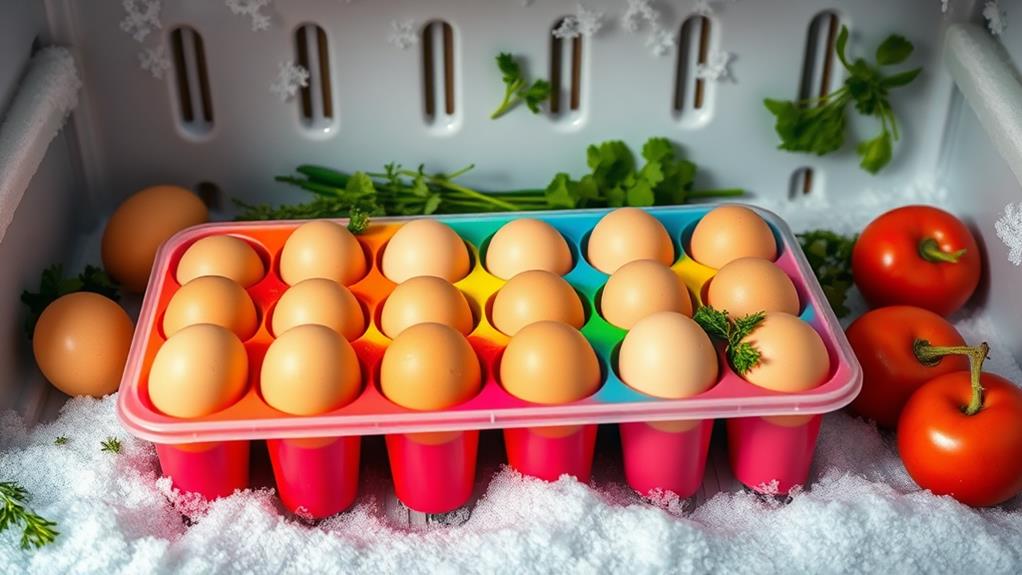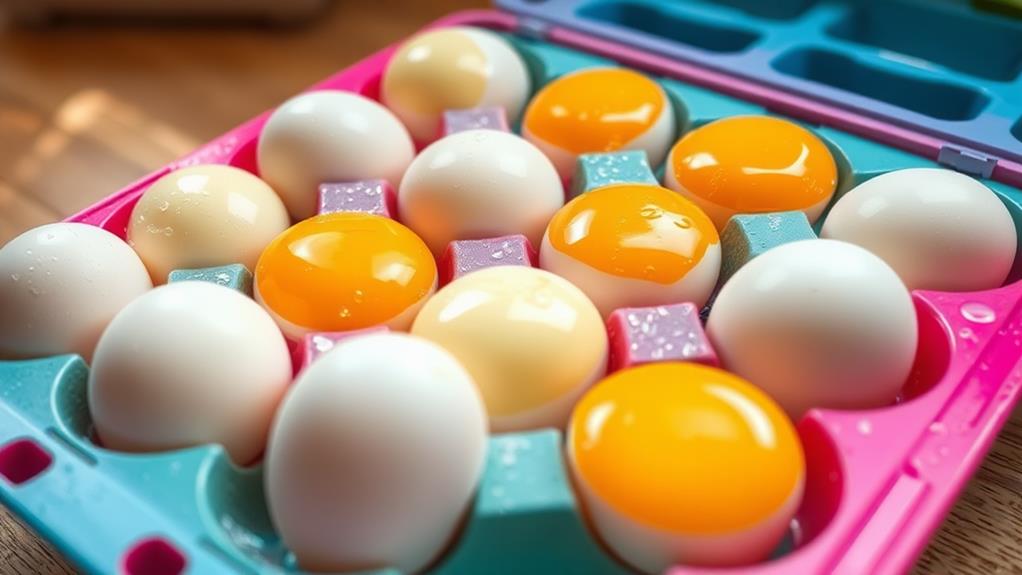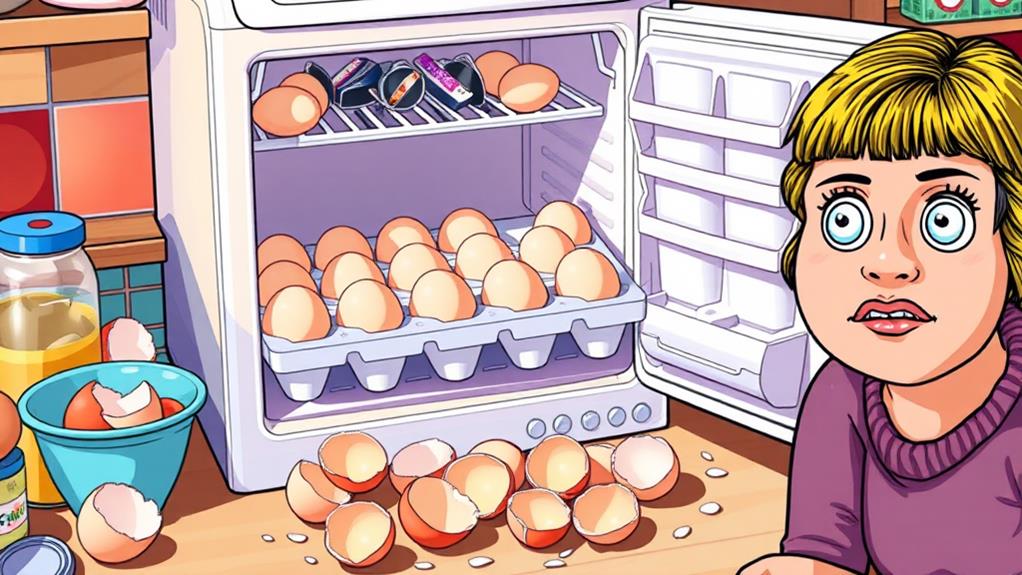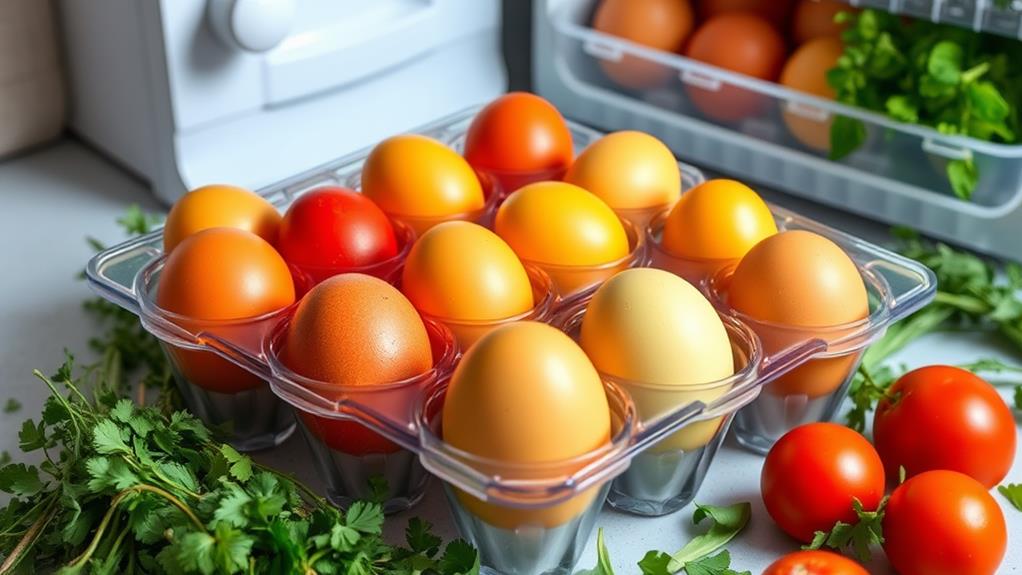You might be wondering why someone would choose to put 14 eggs in an ice cube tray, but this surprising freezer hack offers more than just a quirky kitchen story. By cracking and scrambling the eggs before freezing, you open up a world of meal prep efficiency that can change how you cook. Imagine having perfectly portioned eggs ready to go whenever you need them. But that's just the beginning—there are vital tips and potential pitfalls that can affect your results, making it critical to understand the process fully.
Benefits of Freezing Eggs

Freezing eggs offers you a practical solution for long-term preservation, allowing you to store surplus eggs without worrying about spoilage.
When you freeze eggs, you're not just saving space; you're also making meal prep a breeze! Imagine whipping up scrambled eggs that taste just as good as fresh ones. It's true! The thawing quality of frozen scrambled eggs remains impressive, so you can savor that yummy breakfast whenever you want.
You can freeze egg whites directly without any fuss, but yolks need a little love. A pinch of salt or sugar helps keep them from turning into a solid mass. It's all about that perfect texture!
Instead of using ice cube trays, consider small sealed containers. They prevent overflow and make portioning super easy.
Plus, when it comes time to use your frozen eggs, proper thawing is key. Thaw them in the fridge to keep their quality intact. That way, your scrambled eggs will cook up just like they came straight from the farm.
How to Freeze Eggs Properly
If you've decided to take advantage of freezing eggs, knowing how to do it properly is key to preserving their quality.
You'll want to scramble them or separate the yolks and whites first. This helps prevent texture changes when they thaw. If you're freezing egg yolks, mix them with salt for savory dishes or sugar for baking. This will stop them from becoming too thick and hard to use later.
Avoid freezing whole eggs directly, though! They can overflow in your ice cube tray, and trust me, you don't want that mess.
Egg whites can be frozen without any additives, so feel free to toss them in as they are. If you want an even portion, consider mixing multiple eggs before freezing.
For the best results, use small sealed containers instead of ice cube trays. You can find helpful videos online that show you how to do this every day!
Thawing Frozen Eggs

To get the best results when thawing frozen eggs, it's important to plan ahead. Ideally, you should let those eggs sit in the refrigerator for over 24 hours. This way, they thaw thoroughly without turning into a gooey mess.
Thawing scrambled eggs is pretty straightforward; they usually keep their yummy taste and texture. However, whole eggs can be a bit tricky. You might notice that the yolks turn firm and rubbery, while the egg whites look just fine.
Keep an eye on those whole eggs as they thaw. You don't want any surprises when it's time to cook! Sometimes, you'll find that the yolks end up crystallized and lumpy, which isn't exactly the best for your breakfast plans.
If you're going for scrambled eggs, you're in luck! Thawed scrambled eggs perform just like fresh ones, making your cooking experience a breeze.
Cooking Thawed Eggs
Once those eggs are thawed, it's time to get cooking! You'll find that thawed scrambled eggs actually cook up pretty well, tasting just like fresh ones. They keep their nice consistency, so you can whip up a tasty breakfast without any fuss.
However, be careful with whole thawed eggs. They often turn out rubbery and congealed, which isn't great for frying or scrambling. Stick to scrambled eggs for a delicious dish!
If you've got thawed egg whites, you're in luck! They look just like fresh ones and can be used in all sorts of recipes. Think fluffy omelets or even meringues.
Just remember, thawed yolks need gentle handling since they can get weird textures if you're not careful.
For the best results, try mixing several eggs together before freezing them. It's better to store them in small, sealed containers rather than ice cube trays.
This way, you'll have the right amount ready for your cooking adventures. So, get those pans sizzling and enjoy your creative egg dishes! Who knew freezing eggs could lead to such yummy meals?
Common Mistakes to Avoid

When freezing eggs, it's crucial to dodge some common pitfalls that can ruin their texture and flavor.
First off, avoid freezing whole eggs in ice cube trays. They might overflow, creating a messy situation and leaving you with eggs that just don't taste right after thawing.
If you're freezing egg yolks, mix them with a pinch of salt or sugar first. This simple step helps keep them from clumping together, ensuring a smoother texture when you finally use them.
Also, don't over-beat those eggs! Too much air can lead to a weird texture when you cook them later—nobody wants a wobbly omelet!
Instead of ice cube trays, opt for small, sealed containers. They're great for portion control, and they keep your eggs safe from freezer burn.
Final Thoughts on Freezing Eggs
Freezing eggs can be a game-changer for meal prep, but it's important to remember the best practices to guarantee quality.
First off, while it might seem convenient to pop whole eggs into an ice cube tray, don't do it! They can turn rubbery and weird when you thaw them. Instead, try scrambling those eggs before freezing. They'll keep their yummy taste and texture, making them perfect for your dishes later.
If you're freezing just egg yolks, mix in a pinch of salt or sugar first. This little trick stops them from getting all gooey and gross after thawing.
Also, instead of using trays, opt for small, sealed containers. This way, you avoid any messy spills, and your eggs stay fresh and tasty.
When you're ready to use your frozen eggs, thaw them in the fridge for over 24 hours. It might seem slow, but trust me, it's worth the wait!
Following these simple tips will help you enjoy delicious eggs anytime you want, without any weird textures getting in the way. So, get cracking and start freezing!

